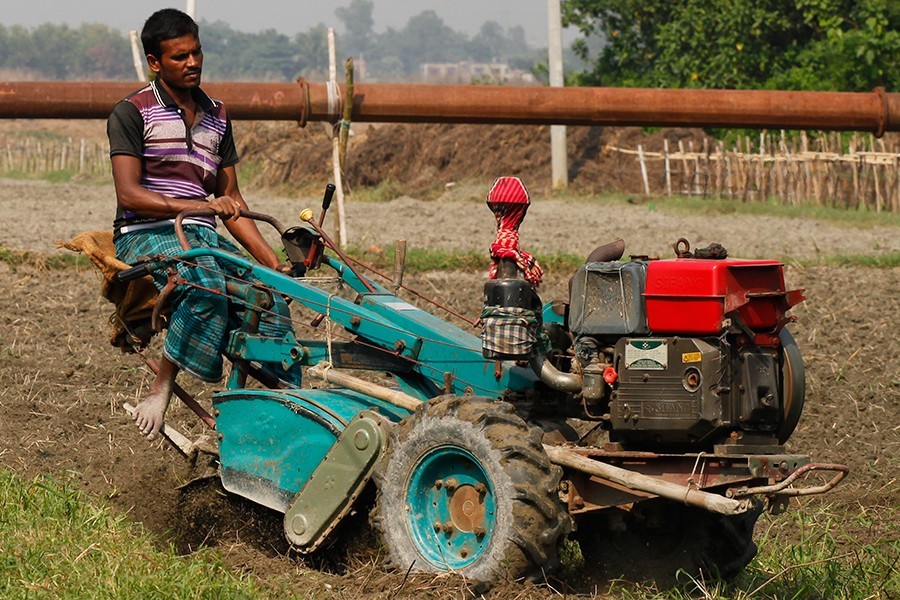No doubt, a silent revolution has taken place in the country's agricultural cultivation, much to the surprise of many. This has been aptly revealed by a statement of the USAID that says Bangladesh is one of the most mechanised countries in Asia when it comes to land preparation. The statement can be further explained by the fact that machines plough 98 per cent of the country's farm land. So, it is clear that although a massive shift has come in the mechanisation of cultivation --- from ox-pulled ploughs to power tillers --- it is only in the primary stage of cultivation where mechanisation has replaced manual labour of humans and animals. The USAID is currently running an agri-mechanisation project in Bangladesh, and it is in the process of its project engagement that the aforesaid observation has been made. The project document further states, as quoted by a local daily, " The planting and harvesting of the 11 million hectares of rice grown every year in Bangladesh is still largely carried out by hand. At present, all crops grown in Bangladesh are largely planted, weeded and harvested by hand."
Given that mechanisation comes as a package, the fractional approach of mechanised land preparation presents itself as just a starter. Mechanisation in the country's major crop cultivation is mostly confined to the use of power tillers, tractors and power pumps. There are other important areas in cultivation where more and more mechanisation can be fruitfully introduced.
The problems here are many. While access to machinery and tools are the key factors, dearth of skilled and semi-skilled workers to operate modern tools, complexity in maintaining and repairing the tools, and power shortage also make mechanisation as a whole package problematic.
Machines and equipment such as seeder, transplanter and power thresher are sure to bring a lot of change in terms of increased productivity and cropping intensity at lower costs than now. In fact, mechanisation could be the only way out to add value to cultivation, especially paddy cultivation. In the Asian region, countries that have reaped the most from mechanised cultivation are China and Thailand. For Bangladesh, this is a transition phase. To encourage farmers to embrace mechanisation, schemes must be in place to provide affordable ways for procuring necessary tools and implements. Forming cooperative societies comprising small farmers could expand the facility to a hugely larger number of farmers. Non-governmental organisations (NGOs) can also have a meaningful role to play in this regard.
The aforementioned project of the USAID appears to address a good deal of the problems facing mechanisation. The $21.4 million project aims to support mechanisation of agriculture and enable more than two hundred thousand farmers to adopt new mechanisation technology. The five-year project scheduled to end in September 2024 is also designed to train manufacturers to develop and adopt new technology of agri-machinery, marketers and machinery service providers (MSPs) and facilitate the MSPs to get access to finance to buy farm machinery. The USAID-funded project is being implemented by the International Maize and Wheat Improvement Centre (CIMMYT) in partnership with the International Development Enterprises (iDE) and the Georgia Institute of Technology. It expects that the project intervention will result in $5.0 million farm machinery sales and attract $3.0 million worth of financing by the financial services sector for all in the agri-machinery value chain, including light engineering companies, marketers and MSPs.
In this connection it is important to refer to the government's agri-mechanisation project which, according to experts, is set in the right direction. The government has approved Tk 30.20 billion for agricultural mechanisation. The agricultural extension department will implement the project by December 2025. The main activities of the project include procurement and distribution of 51,300 machines (combined harvester, rice transplanter, power thresher dryer, power weeder, power sprayer, potato digger, maize sheller) as well as training to rural mechanics, agriculture officers, farmers and entrepreneurs. The project provides for substantial subsidy to farmers -- up to 50 to 70 per cent for procuring agricultural machinery. Farmers in the haor and coastal regions are to be the prime beneficiaries. In course of implementing the project, the authorities are expected to be better placed to take up a comprehensive mechanisation strategy in the near future.
Experts in the field strongly believe that expanding the sphere of mechanisation will result in raising efficiency and economising the cost of cultivation beside substantially reducing post-harvest losses due to wastage. It is commonly believed that due to manual handling, 10 to 15 per cent of the crop, especially paddy, gets lost at harvesting and post-harvesting stages. Machines and equipment such as seeder, transplanter, power thresher are sure to bring a lot of dynamism in terms of increased productivity and cropping intensity at lower costs than now.
These are welcome developments. All stakeholders, especially the Department of Agricultural Extension (DAE), are expected to be supportive enough to the process of a remarkable change in the country's crop cultivation through large-scale mechanisation.


